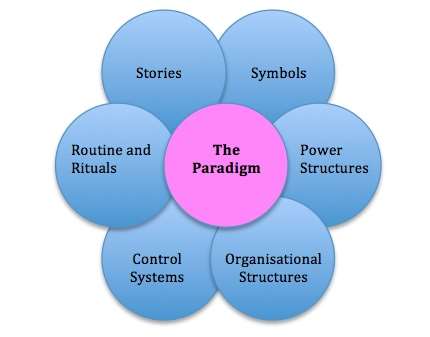Organizational culture can be simply identified as the own unique personality that the respective organization practices. The group of people who works for the organization shares a system of Assumptions, Beliefs, and Values which governs them both individually and with the organizational needs.
The cultural web model developed by Johnson and Scholes in 1993 is an important one, in which six dimensions of the organization culture are defined.
The corporate culture consists of six major components, as structure, power structure, symbols, stories, rituals and control systems. They provide clear guidelines for the employees, about how things are performed within the organizational context; providing influences for the better change management. Cultural elements can be organized in the company to achieve productivity is described accordingly.
- Structure – Mainly refers to the structure of the company, in terms of the management layers and supervisory control. Modern organizations is thereby advised in adjusting to more flat type organization, structure with lower supervisory control, and with higher empowerment created within the organization allowing for higher creativity.
- Power structure – How power is distributed in the organization is stressed here. The personalities or positions that tend to exercise more power are featured from here, which can have a significant influence in the organization. The company is advised to, design higher ranked job functions in a manner in which, the respective leaders would be having a higher willingness towards acceptance of change, whilst driving others as well towards a change.
- Symbols – The symbols with high uniqueness are considered here. Where the symbols associated with the readiness of the organization to accept change can be promoted via communications, which proactively engage the employees with regard to responding to any change.
- Stories – Various stories on the organization, nurtured from the history can be drawn up, here specially the ones which would motivate the employees, in order to accept the change. The success stories could act as a guarantee among the audiences such as customers, publics, competitors, lenders showing a higher credibility of the company capacity and reliability.
- Rituals – Rituals are practices, which have been maintained, periodically in a sequential manner. The ones promoting or encouraging the acceptance of change are to be prioritized.
- Control – This is the control of management over the activities of employees, where authority, and seniority not being used to force others to work, having a more participative style, but with the intention of necessary controls (like the modifying of the employees ideas to a certain level) can achieve better generation of productivity, while enhancing higher employee retention rates initiate accepting the change by the employees.
The Cultural Web is an efficient tool to explore the existing culture of an organization and to define the desired culture. It can be used to understand domineering factors in the present culture, to analyze what culture is needed to deliver a strategy, and to understand the differences. Basically, the Cultural Web helps management to focus on key factors of the culture and their impact on strategic issues and can identify blockages to and facilitators of change in order to improve performance and competitive advantage.
A thorough evaluation of organizational culture is the cultural web model but it also has some constraints. Different people have different cultural views. Therefore, if conducted only by few managers or individuals, the evaluation may not be objective. Since the brief does not address the cultural perspective of individually but as an organization, this model is the right fit.
.
